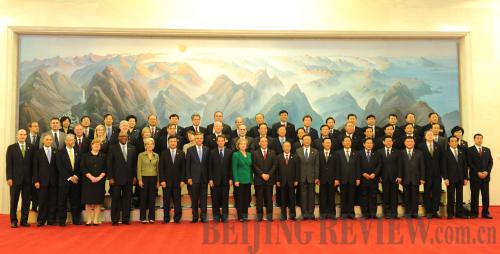|
 |
|
HOPEFUL HORIZONS: Senior officials participating in the second round of the China-U.S. Strategic and Economic Dialogue pose before the opening ceremony of the talks on May 24 in Beijing (RAO AIMIN) |
Different paths, same destination. This ancient Chinese idiom, quoted by U.S. Secretary of State Hillary Clinton, appeared in evidence recently as she and many other high-level U.S. officials crossed the Pacific to join their Chinese counterparts for intensive talks in Beijing.
Thus began the second round of the China-U.S. Strategic and Economic Dialogue (S&ED) from May 24 to 25, focusing squarely on sometimes contentious issues ranging from trade to defense, energy and climate change. Co-chairing the economic and strategic tracks of the S&ED were Chinese Vice Premier Wang Qishan and State Councilor Dai Bingguo, along with U.S. Secretary of State Hillary Clinton and U.S. Treasury Secretary Timothy Geithner, respectively.
Though both sides failed to reach a consensus on each major issue, the talks remained conducive to the ongoing development of a "positive, cooperative and comprehensive partnership" between China and the United States, Dai said at the end of the event.
Indeed, the two countries' most glaring differences—in the political, economic and cultural arenas—have resulted in stark disagreements in recent years. But the fact that world's largest developing country and developed country remain willing to talk openly about their problems represented solid progress, according to analysts.
Contacts
One salient achievement of the latest round was symbolic, but powerful nonetheless. That is, there existed a strong degree of transparency, despite the clear inability of both sides to achieve mutual agreements, said Jin Canrong, Associate Dean of the School of International Studies at Renmin University of China.
While addressing their problems, he added, the Chinese delegates and their counterparts from Washington also gained a tangibly better understanding of each other's future policy options. This will enable them to maintain secure bilateral relations.
Chinese President Hu Jintao and U.S. President Barack Obama agreed to create the S&ED as the principal forum to address long-term strategic issues between the two countries during their first meeting in London in April 2009. Three months later, the first round of the S&ED was held in Washington, D.C.
Since the beginning of this year, however, Sino-U.S. relations have hit a rough patch owing to sensitive issues—in particular, U.S. approval of a multibillion-dollar weapons sale to Taiwan and a meeting by President Obama with the Dalai Lama.
Against this backdrop, Hu and Obama met in Washington, D.C. in April on the sidelines of the Nuclear Security Summit, where they reaffirmed their commitment to a strong Sino-U.S. relationship. In mid-May, the two sides went on to hold a human rights dialogue, again in Washington, D.C.
The second round of the S&ED, meanwhile, provided further opportunities. At the opening, President Hu underlined the importance of bilateral interactions by saying that "not even the most sophisticated telecommunication technology can replace face-to-face exchanges."
In a discreet reference to arms sales to Taiwan and other issues, Hu reiterated that Beijing and Washington should respect mutual core interests and major concerns—such as national sovereignty and territorial integrity.
| 